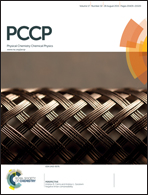Determining adsorbate configuration on alumina surfaces with 13C nuclear magnetic resonance relaxation time analysis
Abstract
Relative strengths of surface interaction for individual carbon atoms in acyclic and cyclic hydrocarbons adsorbed on alumina surfaces are determined using chemically resolved 13C nuclear magnetic resonance (NMR) T1 relaxation times. The ratio of relaxation times for the adsorbed atoms T1,ads to the bulk liquid relaxation time T1,bulk provides an indication of the mobility of the atom. Hence a low T1,ads/T1,bulk ratio indicates a stronger surface interaction. The carbon atoms associated with unsaturated bonds in the molecules are seen to exhibit a larger reduction in T1 on adsorption relative to the aliphatic carbons, consistent with adsorption occurring through the carbon–carbon multiple bonds. The relaxation data are interpreted in terms of proximity of individual carbon atoms to the alumina surface and adsorption conformations are inferred. Furthermore, variations of interaction strength and molecular configuration have been explored as a function of adsorbate coverage, temperature, surface pre-treatment, and in the presence of co-adsorbates. This relaxation time analysis is appropriate for studying the behaviour of hydrocarbons adsorbed on a wide range of catalyst support and supported-metal catalyst surfaces, and offers the potential to explore such systems under realistic operating conditions when multiple chemical components are present at the surface.



 Please wait while we load your content...
Please wait while we load your content...